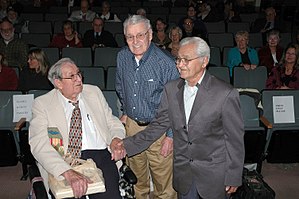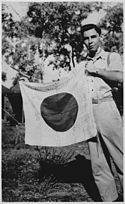
Attu is an island in the Near Islands. It is the westernmost point of the U.S. state of Alaska. The island became uninhabited in 2010, making it the largest uninhabited island to be politically part of the United States.

Kiska is one of the Rat Islands, a group of the Aleutian Islands of Alaska. It is about 22 miles (35 km) long and varies in width from 1.5 to 6 miles. It is part of Aleutian Islands Wilderness and as such, special permission is required to visit it. The island has no permanent population.
Adak Island or Father Island is an island near the western extent of the Andreanof Islands group of the Aleutian Islands in Alaska. Alaska's southernmost city, Adak, is located on the island. The island has a land area of 274.59 square miles (711.18 km2), measuring 33.9 miles (54.5 km) long and 22 miles (35 km) wide, making it the 25th largest island in the United States.

The Aleutian Islands campaign was a military campaign fought between 3 June 1942 and 15 August 1943 on and around the Aleutian Islands in the American Theater of World War II. It was the only military campaign of World War II fought on North American soil.

Eareckson Air Station, formerly Shemya Air Force Base, is a United States Air Force military airport located on the island of Shemya, in the Alaskan Aleutian Islands.

The Eleventh Air Force (11 AF) is a Numbered Air Force of the United States Air Force Pacific Air Forces (PACAF). It is headquartered at Joint Base Elmendorf–Richardson, Alaska.
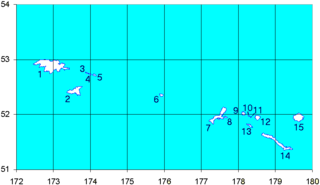
Buldir Island is a small island in the western Aleutian Islands of the U.S. state of Alaska. It is 4.3 miles (6.9 km) long and 2.5 miles (4.0 km) wide with an area of 7.4482 square miles (19.291 km2). Buldir is farther from the nearest land than any other Aleutian Island. Its nearest neighbors are Kiska in the Rat Island group, 68 miles (109 km) to the east, and Shemya in the Near Island group, 64 miles (103 km) to the west. Buldir Island is uninhabited. It is part of the Alaska Maritime National Wildlife Refuge. It has been designated a Research Natural Area.
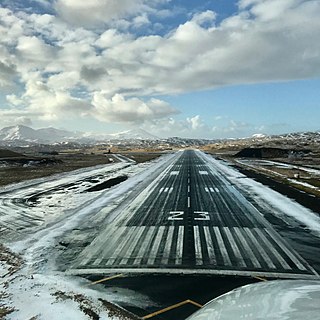
Adak Airport is a state-owned public-use airport located west of Adak, on Adak Island in the Aleutian Islands in the U.S. state of Alaska. The airport is the farthest western airfield with scheduled passenger air service in the entire United States at 176.64W.
Organization of Japanese Alaskan Strike Group (Aleutians)

The Alaskan Command (ALCOM) is a joint subordinate unified command of the United States Northern Command, responsible for operations in and around the State of Alaska. Alaskan Command is charged with maintaining air sovereignty, deploying forces for worldwide contingencies as directed by the Commander, US Northern Command, providing support to federal and state authorities during civil emergencies and conducting joint training for the rapid deployment of combat forces. ALCOM combined forces include more than 16,000 Air Force, Army, Navy and Coast Guard personnel, and 3,700 guardsmen and reservists. Recently, the Command Representative for Missile Defense position was created to be the focal point for all issues related to Ground-Based Midcourse Defense in Alaska, in support of Alaskan Command, the Alaska NORAD Region, and the Eleventh Air Force.

The Battle of Attu, which took place on 11–30 May 1943, was a battle fought between forces of the United States, aided by Canadian reconnaissance and fighter-bomber support, and Japan on Attu Island off the coast of the Territory of Alaska as part of the Aleutian Islands campaign during the American Theater and the Pacific Theater. Attu is the only land battle in which Japanese and American forces fought in snowy conditions, in contrast with the tropical climate in the rest of the Pacific. The more than two-week battle ended when most of the Japanese defenders were killed in brutal hand-to-hand combat after a final banzai charge broke through American lines.

The Japanese occupation of Kiska took place between 6 June 1942 and 28 July 1943 during the Aleutian Islands campaign of the American Theater and the Pacific Theater of World War II. The Japanese occupied Kiska and nearby Attu Island in order to protect the northern flank of the Japanese Empire.
Amchitka Air Force Base is an abandoned Air Force Base located on Amchitka, in the Rat Islands group of the Aleutian Islands in southwest Alaska.
Alexai Point Army Airfield is an abandoned World War II airfield with two runways laid across Alexai Point on Attu Island, Alaska. The remains of the Seabee built airbase are located about 4 miles east of the closed Casco Cove Coast Guard Station, directly across Massacre Bay.

The Japanese occupation of Attu was the result of an invasion of the Aleutian Islands in Alaska during World War II. Imperial Japanese Army troops landed on 7 June 1942, the day after the invasion of nearby Kiska. Along with the Kiska landing, it was the first time that the continental United States was invaded and occupied by a foreign power since the War of 1812, and was the second of the only two invasions of the United States during World War II. The occupation ended with the Allied victory in the Battle of Attu on 30 May 1943.

The military history of the Aleutian Islands began almost immediately following the purchase of Alaska from the Russian Empire by the United States in 1867. Prior to the early 20th century, the Aleutian Islands were essentially ignored by the United States Armed Forces, although the islands played a small role in the Bering Sea Arbitration when a number of British and American vessels were stationed at Unalaska to enforce the arbitrators' decision. By the early 20th century, a number of war strategies examined the possibility of conflict breaking out between the Empire of Japan and the United States. While the Aleutian Islands were seen as a potential staging point for invasions by either side, this possibility was dismissed owing to the islands' dismal climate. In 1922, the Washington Naval Treaty was signed, after which the United States Navy began to take an interest in the islands. However, nothing of significance was to materialize until World War II.

Edgar Walker was an American veteran of World War II, businessman, publisher and writer. Walker was the penultimate surviving member of "Castner's Cutthroats", a regiment consisting of sixty-five men who performed reconnaissance missions in the Aleutian Islands during World War II. Castner's Cutthroats was the unofficial name of the 1st Alaskan Combat Intelligence Platoon.
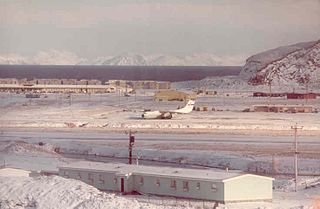
Naval Air Facility Adak, was a United States Navy airport located west of Adak, on Adak Island in the U.S. state of Alaska. After its closure in 1997, it was reopened as Adak Airport. The facility was designated a National Historic Landmark for its role in World War II, although most of its elements from that period have been demolished or lie in ruins.

The landing at Amchitka on 12 January 1943 was the unopposed amphibious landing operation and occupation of Amchitka island by American forces during the Aleutian Islands campaign during World War II.
VP-3 was a Patrol Squadron of the U.S. Navy. The squadron was established as Patrol Squadron 16-F (VP-16F) on 2 January 1937, redesignated Patrol Squadron 16 (VP-16) on 1 October 1937, redesignated Patrol Squadron 41 (VP-41) on 1 July 1939, redesignated Bombing Squadron 136 (VB-136) on 1 March 1943, redesignated Patrol Bombing Squadron 136 (VPB-136) on 1 October 1944, redesignated Patrol Squadron 136 (VP-136) on 15 May 1946, redesignated Medium Patrol Squadron (landplane) 3 (VP-ML-3) on 15 November 1946, redesignated Patrol Squadron 3 (VP-3) on 1 September 1948, and was disestablished on 1 November 1955. It was the second squadron to be designated VP-3, the first VP-3 was redesignated VP-32 on 1 July 1939.
